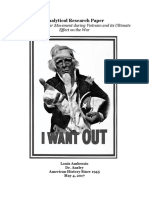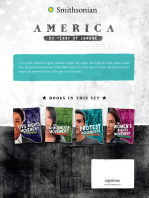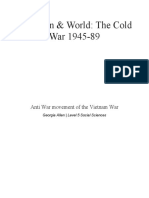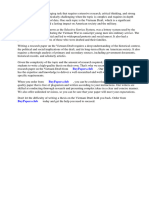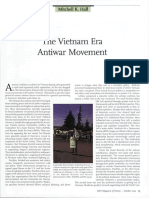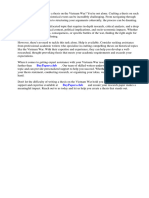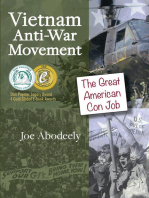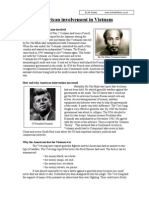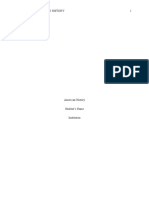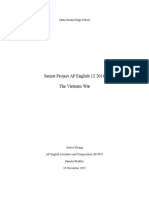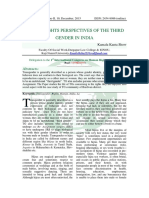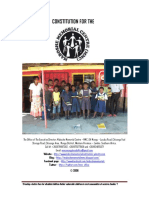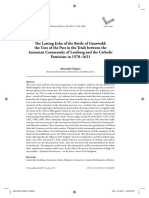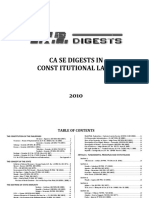Professional Documents
Culture Documents
CH 30 3 A Nation Divided
CH 30 3 A Nation Divided
Uploaded by
avihihiOriginal Description:
Original Title
Copyright
Available Formats
Share this document
Did you find this document useful?
Is this content inappropriate?
Report this DocumentCopyright:
Available Formats
CH 30 3 A Nation Divided
CH 30 3 A Nation Divided
Uploaded by
avihihiCopyright:
Available Formats
p0948-953aspe-0830s3
10/17/02
9:22 AM
Page 948
Page 1 of 6
A Nation Divided
MAIN IDEA An antiwar movement in the U.S. pitted supporters of the governments war policy against those who opposed it. WHY IT MATTERS NOW The painful process of healing a divided nation continues today. Terms & Names
draft New Left Students for a Democratic Society (SDS) Free Speech Movement dove hawk
One American's Story
In 1969, Stephan Gubar was told to report for possible military service in Vietnam. Gubar, 22, a participant in the civil rights movement, had filed as a conscientious objector (CO), or someone who opposed war on the basis of religious or moral beliefs. He was granted 1-A-O status, which meant that while he would not be forced to carry a weapon, he still qualified for noncombatant military duty. That year, Gubar was drafted called for military service. As did many other conscientious objectors, Gubar received special training as a medic. He described the memorable day his training ended.
A PERSONAL VOICE STEPHAN GUBAR The thing that stands out most was . . . being really scared, being in formation and listening to the names and assignments being called. The majority of COs I knew had orders cut for Vietnam. And even though I could hear that happening, even though I could hear that every time a COs name came up, the orders were cut for Vietnam, I still thought there was a possibility I might not go. Then, when they called my name and said Vietnam,. . . I went to a phone and I called my wife. It was a tremendous shock.
quoted in Days of Decision
While many young Americans proudly went off to war, some found ways to avoid the draft, and others simply refused to go. The growing protest movement sharply divided the country between supporters and opponents of the governments policy in Vietnam.
MATTERS OF CONSCIENCE
Stephan Gubar and the Vietnam War
The Working Class Goes to War
The idea of ghting a war in a faraway place for what they believed was a questionable cause prompted a number of young Americans to resist going to Vietnam.
A MANIPULATABLE DRAFT Most soldiers who fought in Vietnam were called into combat under the countrys Selective Service System, or draft, which had been established during World War I. Under this system, all males had to register with their local draft boards when they turned 18. All registrants were screened, and unless they were excludedsuch as for medical reasonsin the event of war, men between the ages of 18 and 26 would be called into military service.
948
CHAPTER 30
p0948-953aspe-0830s3
10/17/02
9:22 AM
Page 949
Page 2 of 6
Vocabulary deferment: the act or instance of delaying
Skillbuilder Answer 1965 through 1968. A. Answer African Americans were ghting and dying for a country that still discriminated against them.
MAIN IDEA
AFRICAN AMERICANS IN VIETNAM African Americans served in disproportionate numbers as ground combat troops. During the rst several years of the war, blacks accounted for more than 20 percent of American combat deaths despite representing only about 10 percent of the U.S. population. The Defense Department took steps to correct that imbalance by instituting a draft lottery system in 1969. Martin Luther King, Jr., had refrained from speaking out against the war for fear that it would divert attention from the civil rights movement. But he could not maintain that stance for long. In 1967 he lashed out against what he called the cruel irony of American blacks dying for a country that still treated them as second-class citizens.
A PERSONAL VOICE DR. MARTIN LUTHER KING, JR. We were taking the young black men who had been crippled by our society and
sending them eight thousand miles away to guarantee liberties in Southeast Asia which they had not found in Southwest Georgia and East Harlem. . . . We have been repeatedly faced with the cruel irony of watching Negro and white boys on TV screens as they kill and die together for a nation that has been unable to seat them together in the same schools.
quoted in Americas Vietnam War: A Narrative History
Synthesizing A Why did King call African Americans ghting in Vietnam an irony?
Racial tension ran high in many platoons, and in some cases, the hostility led to violence. The racism that gripped many military units was yet another factor that led to low troop morale in Vietnam. A
Despite racial tensions, black and white soldiers fought side by side in Vietnam.
U.S. Military Personnel in Vietnam*
600 536,000 500 Troops (in thousands) 400 300 200 100 0 1963
1964
1965
1966
1967
1968
1969
1970
1971 1972
*Year-end figures
Source: Statistical Abstract of the United States, 1985; Encyclopedia Americana
SKILLBUILDER Interpreting Graphs
What years signaled a rapid increase in the deployment of U.S. troops?
A Life magazine cover shows new draft inductees arriving for training at Fort Knox, Kentucky.
As Americans doubts about the war grew, thousands of men attempted to nd ways around the draft, which one man characterized as a very manipulatable system. Some men sought out sympathetic doctors to grant medical exemptions, while others changed residences in order to stand before a more lenient draft board. Some Americans even joined the National Guard or Coast Guard, which often secured a deferment from service in Vietnam. One of the most common ways to avoid the draft was to receive a college deferment, by which a young man enrolled in a university could put off his military service. Because university students during the 1960s tended to be white and nancially well-off, many of the men who fought in Vietnam were lower-class whites or minorities who were less privileged economically. With almost 80 percent of American soldiers coming from lower economic levels, Vietnam was a working-class war.
p0948-953aspe-0830s3
10/17/02
9:22 AM
Page 950
Page 3 of 6
Two U.S. nurses rest at Cam Ranh Bay, the major entry point in South Vietnam for American supplies and troops.
WOMEN JOIN THE RANKS While the U.S. military in the 1960s did not allow females to serve in combat, 10,000 women served in Vietnammost of them as military nurses. Thousands more volunteered their services in Vietnam to the American Red Cross and the United Services Organization (USO), which delivered hospitality and entertainment to the troops. As the military marched off to Vietnam to ght against communist guerrillas, some of the men at home, as well as many women, waged a battle of their own. Tensions ared across the country as many of the nations youths began to voice their opposition to the war.
The Roots of Opposition
Even before 1965, students were becoming more active socially and politically. Some participated in the civil rights struggle, while others pursued public service. As America became more involved in the war in Vietnam, college students across the country became a powerful and vocal group of protesters.
THE NEW LEFT The growing youth movement of the 1960s became known as the New Left. The movement was new in relation to the old left of the 1930s, which had generally tried to move the nation toward socialism, and, in some cases, communism. While the New Left movement did not preach socialism, its followers demanded sweeping changes in American society. Voicing these demands was one of the better-known New Left organizations, Students for a Democratic Society (SDS), founded in 1960 by Tom Hayden and Al Haber. The group charged that corporations and large government institutions had taken over America. The SDS called for a restoration of participatory democracy and greater individual freedom. In 1964, the Free Speech Movement (FSM) gained prominence at the University of California at Berkeley. The FSM grew out of a clash between students and administrators over free speech on campus. Led by Mario Savio, a philosophy student, the FSM focused its criticism on what it called the American machine, the nations faceless and powerful business and government institutions. B CAMPUS ACTIVISM Across the country the ideas of the FSM and SDS quickly spread to college campuses. Students addressed mostly campus issues, such as dress codes, curfews, dormitory regulations, and mandatory Reserved Ofcer
B. Answer Corporations and government institutions were growing too dominant and were inhibiting personal freedom.
MAIN IDEA
Making Inferences B What concerns about American democratic society did the New Left voice?
950
CHAPTER 30
p0948-953aspe-0830s3
10/17/02
9:22 AM
Page 951
Page 4 of 6
Training Corps (ROTC) programs. At Fairleigh Dickinson University in New Jersey, students marched merely as an expression of general student discontent. With the onset of the Vietnam War, students across the country found a galvanizing issue and joined together in protest. By the mid-sixties, many youths believed the nation to be in need of fundamental change.
The Protest Movement Emerges
Throughout the spring of 1965, groups at a number of colleges began to host teach-ins to protest the war. At the University of Michigan, where only a year before President Johnson had announced his sweeping Great Society Program, teachers and students now assailed his war policy. This is no longer a casual form of campus spring fever, journalist James Reston noted about the growing demonstrations. As the war continued, the protests grew and divided the country.
MAIN IDEA
Summarizing C For what reasons did the protesters oppose the Vietnam War?
C. Answer Protesters felt that America had no business in Vietnam; the war was draining American strength from other parts of the world; the war was morally unjust.
THE MOVEMENT GROWS In April of 1965, SDS helped organize a march on Washington, D.C., by some 20,000 protesters. By November of that year, a protest rally in Washington drew more than 30,000. Then, in February of 1966, the Johnson administration changed deferments for college students, requiring students to be in good academic standing in order to be granted a deferment. Campuses around the country erupted in protest. SDS called for civil disobedience at Selective Service Centers and openly counseled students to ee to Canada or Sweden. By the end of 1969, SDS had chapters on nearly 400 campuses. Youths opposing the war did so for several reasons. The most common was the belief that the conict in Vietnam was basically a civil war and that the U.S. military had no business there. Some said that the oppressive South Vietnamese regime was no better than the Communist regime it was ghting. Others argued that the United States could not police the entire globe and that war was draining American strength in other important parts of the world. Still others saw war simply as morally unjust. C The antiwar movement grew beyond college campuses. Small numbers of returning veterans began to protest the HISTORICAL war, and folk singers such as the trio Peter, Paul, and Mary, and Joan Baez used music as a popular protest vehicle. The number one song in September 1965 was Eve of Destruction, in which singer Barry McGuire stressed the THE BALLAD OF THE GREEN BERETS ironic fact that in the 1960s an American male could be draft-
S P O TLIG H T
ed at age 18 but had to be 21 to vote:
The Eastern world, it is explodin, Violence aring, bullets loadin, Youre old enough to kill, but not for votin, You dont believe in war, but whats that gun youre totin?
Not every Vietnam-era pop song about war was an antiwar song. At the top of the charts for ve weeks in 1966 was The Ballad of the Green Berets by Staff Sergeant Barry Sadler of the U.S. Army Special Forces, known as the Green Berets: Fighting soldiers from the sky, Fearless men who jump and die, Men who mean just what they say, The brave men of the Green Beret. The recording sold over a million copies in its rst two weeks of release and was Billboard magazines song of the year.
FROM PROTEST TO RESISTANCE By 1967, the antiwar movement had intensied, with no sign of slowing down. We were having no effect on U.S. policy, recalled one protest leader, so we thought we had to up the ante. In the spring of 1967, nearly half a million protesters of all ages gathered in New Yorks Central Park. Shouting Burn cards, not people! and Hell, no, we wont go! hundreds tossed their draft cards into a bonre. A woman from New Jersey told a reporter, So many of us are frustrated. We want to criticize this war because we think its wrong, but we want to do it in the framework of loyalty.
The Vietnam War Years 951
p0948-953aspe-0830s3
10/17/02
9:22 AM
Page 952
Page 5 of 6
DIFFICULT
D E C I SI O N S
RESIST THE DRAFT OR SERVE YOUR COUNTRY?
As the ghting in Vietnam intensied, young men of draft age who opposed the war found themselves considering one of two options: register with the draft board and risk heading off to war, or nd a way to avoid military service. Ways to avoid service included medical and educational deferments. But a great many men did not qualify for these. The choices that remained, such as eeing the country, going to jail, or giving in and joining the ranks, came with a high price. Once a decision was made, there was no turning back. 1. Imagine you oppose the war and are called to serve in Vietnam. What decision would you make? Would you feel guilty if you avoided the draft? If you chose to serve, how would you view those who did not serve your country? 2. Do you think more young men would have been willing to serve had this been a different war? Explain.
Others were more radical in their view. David Harris, who would spend 20 months in jail for refusing to serve in Vietnam, explained his motives.
A PERSONAL VOICE DAVID HARRIS Theoretically, I can accept the notion that there are circumstances in which you have to kill people. I could not accept the notion that Vietnam was one of those circumstances. And to me that left the option of either sitting by and watching what was an enormous injustice . . . or [nding] some way to commit myself against it. And the position that I felt comfortable with in committing myself against it was total noncooperationI was not going to be part of the machine.
quoted in The War Within
Draft resistance continued from 1967 until President Nixon phased out the draft in the early 1970s. During these years, the U.S. government accused more than 200,000 men of draft offenses and imprisoned nearly 4,000 draft resisters. (Although some were imprisoned for four or ve years, most won parole after 6 to 12 months.) Throughout these years, about 10,000 Americans ed, many to Canada. D In October of 1967, a demonstration at Washingtons Lincoln Memorial drew about 75,000 protesters. After listening to speeches, approximately 30,000 demonstrators locked arms for a march on the Pentagon in order to disrupt the center of the American war machine, as one organizer explained. As hundreds of protesters broke past the military police and mounted the Pentagon steps, they were met by tear gas and clubs. About 1,500 demonstrators were injured and at least 700 arrested.
MAIN IDEA
Evaluating D Do you think it was right for the government to imprison draft resisters? Explain.
This sign reects the view of many Americans that the antiwar protests undermined the war effort in Vietnam.
WAR DIVIDES THE NATION By 1967, Americans increasingly found themselves divided into two camps regarding the war. Those who strongly opposed the war and believed the United States should withdraw were known as doves. Feeling just as strongly that America should unleash much of its greater military force to win the war were the hawks. Despite the visibility of the antiwar protesters, a majority of American citizens in 1967 still remained committed to the war. Others, while less certain about the proper U.S. role in Vietnam, were shocked to see protesters publicly criticize a war in which their fellow Americans were ghting and dying. A poll taken in December of 1967 showed that 70 percent of Americans believed the war protests were acts of disloyalty. A reghter who lost his son in Vietnam articulated the bitter feelings a number of Americans felt toward the antiwar movement.
D. Possible Answers Yes: It was fair, since resisting the draft was a serious offense. No: it was unfair; people should not be forced into war.
A PERSONAL VOICE Im bitter. . . . Its people like us who give up our sons for the country. . . . The college types, the professors, they go to Washington and tell the government what to do. . . . But their sons, they dont end up in the swamps over there, in Vietnam. No sir. Theyre deferred, because theyre in school. Or they get sent to safe places. . . . What bothers me about the peace crowd is that you can tell from their attitude, the way they look and what they say, that they dont really love this country.
a reghter quoted in Working-Class War
952
p0948-953aspe-0830s3
10/17/02
9:22 AM
Page 953
Page 6 of 6
MAIN IDEA
Evaluating E What were the key issues that divided America?
Responding to antiwar posters, Americans who supported the governments Vietnam policy developed their own slogans: Support our men in Vietnam and Americalove it or leave it. E
E. Answer Those who supported Americas involvement in the war thought the U.S. should take an even more powerful stance to win the war. Those who opposed wanted U.S. troops to withdraw immediately.
JOHNSON REMAINS DETERMINED Throughout the turmoil and division that engulfed the country during the early years of the war, President Johnson remained rm. Attacked by doves for not withdrawing and by hawks for not increasing military power rapidly enough, Johnson was dismissive of both groups and their motives. He continued his policy of slow escalation.
A PERSONAL VOICE LYNDON B. JOHNSON There has always been confusion, frustration, and difference of opinion in this
country when there is a war going on. . . . You know what President Roosevelt went through, and President Wilson in World War I. He had some senators from certain areas . . . that gave him serious problems until victory was assured. . . . We are going to have these differences. No one likes war. All people love peace. But you cant have freedom without defending it.
quoted in No Hail, No Farewell
However, by the end of 1967, Johnsons policyand the continuing stalematehad begun to create turmoil within his own administration. In November, Defense Secretary Robert McNamara, a key architect of U.S. escalation in Vietnam, quietly announced he was resigning to become head of the World Bank. It didnt add up, McNamara recalled later. What I was trying to nd out was how . . . the war went on year after year when we stopped the inltration [from North Vietnam] or shrunk it and when we had a very high body count and so on. It just didnt make sense. As it happened, McNamaras resignation came on the threshold of the most tumultuous year of the sixties. In 1968 the warand Johnsons presidencywould take a drastic turn for the worse.
1. TERMS & NAMES For each of the following, write a sentence explaining its signicance.
draft New Left Students for a Democratic Society (SDS) Free Speech Movement dove hawk
MAIN IDEA
2. TAKING NOTES Re-create the tree diagram below on your paper. Then ll it in with examples of student organizations, issues, and demonstrations of the New Left. The New Left Student Organizations examples Issues examples
CRITICAL THINKING
3. DEVELOPING HISTORICAL PERSPECTIVE Imagine it is 1967. Do you think you would ally yourself with the hawks or the doves? Give reasons that support your position.
4. EVALUATING Do you agree that antiwar protests were acts of disloyalty? Why or why not? Demonstrations examples
5. ANALYZING VISUAL SOURCES This antiwar poster is a parody of the World War I Uncle Sam poster (shown on page 588), which states, I want you for the U.S. Army. Why might the artist have chosen this American character to express the antiwar message?
The Vietnam War Years 953
You might also like
- Full Chapter Putin S Wars The Rise of Russia S New Imperialism 3Rd Edition Marcel H Van Herpen PDFDocument42 pagesFull Chapter Putin S Wars The Rise of Russia S New Imperialism 3Rd Edition Marcel H Van Herpen PDFbarbara.fuqua460100% (7)
- Bring the War Home: The White Power Movement and Paramilitary AmericaFrom EverandBring the War Home: The White Power Movement and Paramilitary AmericaRating: 4 out of 5 stars4/5 (57)
- Kami Export - Guided Reading 3 Nation DividedDocument3 pagesKami Export - Guided Reading 3 Nation DividedPeyton McDonaldNo ratings yet
- Analytical Paper AmbrosioDocument15 pagesAnalytical Paper AmbrosioLouis AmbrosioNo ratings yet
- Golda MeirDocument743 pagesGolda MeirEdith Bodo100% (3)
- PK DNT Draft AnnaDocument89 pagesPK DNT Draft AnnaM Subba Rao75% (4)
- Scheidel - Studying The State PDFDocument32 pagesScheidel - Studying The State PDFMo Za PiNo ratings yet
- Master Script - 1960s USDocument9 pagesMaster Script - 1960s USalice.assayagNo ratings yet
- Chapter 20 - Section 3 - War Divides AmericaDocument33 pagesChapter 20 - Section 3 - War Divides Americaapi-285010771No ratings yet
- Vietnam War DBQDocument3 pagesVietnam War DBQej92892100% (2)
- Turmoil of 60s & 70sDocument18 pagesTurmoil of 60s & 70sPradipta Kumar GhoshNo ratings yet
- History EssayDocument2 pagesHistory EssayJohnNo ratings yet
- At the Crossroads of Justice: My Lai and Son Thang—American Atrocities in VietnamFrom EverandAt the Crossroads of Justice: My Lai and Son Thang—American Atrocities in VietnamNo ratings yet
- Term Paper On Vietnam WarDocument5 pagesTerm Paper On Vietnam Warc5td1cmc100% (1)
- First In, Last Out: An American Paratrooper in Vietnam with the 101st and Vietnamese AirborneFrom EverandFirst In, Last Out: An American Paratrooper in Vietnam with the 101st and Vietnamese AirborneNo ratings yet
- Lecture ch29Document41 pagesLecture ch29api-171412573No ratings yet
- Resister: A Story of Protest and Prison during the Vietnam WarFrom EverandResister: A Story of Protest and Prison during the Vietnam WarRating: 5 out of 5 stars5/5 (1)
- America During The Vietnam WarDocument7 pagesAmerica During The Vietnam WarFredrik AhlstenNo ratings yet
- Assertiveness Skills BasicsDocument4 pagesAssertiveness Skills BasicsKen GeorgeNo ratings yet
- Research Paper On Vietnam WarDocument7 pagesResearch Paper On Vietnam Warzyfofohab0p2100% (1)
- Wip DoneDocument6 pagesWip DonepepeNo ratings yet
- European Viet DraftDocument4 pagesEuropean Viet DraftgeoNo ratings yet
- Fiche CM Civi UsDocument11 pagesFiche CM Civi UsNoémieNo ratings yet
- Research Paper On Vietnam DraftDocument5 pagesResearch Paper On Vietnam Drafthubegynowig3100% (1)
- European Viet Finished.Document4 pagesEuropean Viet Finished.geoNo ratings yet
- Vietnam War Dissertation IdeasDocument7 pagesVietnam War Dissertation IdeasCollegePaperHelpFargo100% (1)
- Year Of The Hawk: America's Descent into Vietnam, 1965From EverandYear Of The Hawk: America's Descent into Vietnam, 1965Rating: 4.5 out of 5 stars4.5/5 (3)
- Vietnam DBQDocument4 pagesVietnam DBQLeigh GoldsteinNo ratings yet
- Opening the American Mind: Recognizing the Threat to the NationFrom EverandOpening the American Mind: Recognizing the Threat to the NationNo ratings yet
- Rich Man's War, Poor Man's Fight: Race, Class, and Power in the Rural South during the First World WarFrom EverandRich Man's War, Poor Man's Fight: Race, Class, and Power in the Rural South during the First World WarRating: 2 out of 5 stars2/5 (2)
- The Vietnam Era Antiwar Movement: Mitchell K. HallDocument6 pagesThe Vietnam Era Antiwar Movement: Mitchell K. HallNetaniaLimNo ratings yet
- Good Vietnam War Thesis StatementsDocument6 pagesGood Vietnam War Thesis Statementskarinathomasdenver100% (2)
- CH 29Document40 pagesCH 29Anna O’ConnorNo ratings yet
- Vietnam War Thesis PaperDocument6 pagesVietnam War Thesis Paperangelaruizhartford100% (2)
- Vietnam War Research PaperDocument8 pagesVietnam War Research Papermtxziixgf100% (1)
- Vietnam War Research Paper ThesisDocument4 pagesVietnam War Research Paper Thesiswqbdxbvkg100% (1)
- Vietnam War Research Paper ExamplesDocument7 pagesVietnam War Research Paper Examplesafeaxbgqp100% (1)
- Term PaperDocument12 pagesTerm Paperapi-462694475No ratings yet
- The Vietnam Lobby: The American Friends of Vietnam, 1955-1975From EverandThe Vietnam Lobby: The American Friends of Vietnam, 1955-1975No ratings yet
- U.S. Involvement in Vietnam WarDocument7 pagesU.S. Involvement in Vietnam Warapi-565360584No ratings yet
- Tori Berb1Document4 pagesTori Berb1Tori BerbaNo ratings yet
- Confronting the War Machine: Draft Resistance during the Vietnam WarFrom EverandConfronting the War Machine: Draft Resistance during the Vietnam WarRating: 3 out of 5 stars3/5 (3)
- Vietnam Us InvolvementDocument3 pagesVietnam Us InvolvementRakesh KonwarNo ratings yet
- Battle Green Vietnam: The 1971 March on Concord, Lexington, and BostonFrom EverandBattle Green Vietnam: The 1971 March on Concord, Lexington, and BostonNo ratings yet
- Thesis Statement Vietnam WarDocument4 pagesThesis Statement Vietnam Warkelleyhunterlasvegas100% (2)
- American Civil War ThesisDocument7 pagesAmerican Civil War Thesisbsk89ztx100% (2)
- Thesis Statement For Civil War Research PaperDocument6 pagesThesis Statement For Civil War Research Paperdwf6nx2z100% (1)
- Causes of The American Civil War Research PaperDocument8 pagesCauses of The American Civil War Research Papermkcewzbnd100% (1)
- 4.3 Notes History PresentacionesDocument2 pages4.3 Notes History PresentacionesGabriela RiveraNo ratings yet
- Running Head: AMERICAN HISTORY 1Document4 pagesRunning Head: AMERICAN HISTORY 1Brian KinyuaNo ratings yet
- Senior Project AP English 12 2016 The Vietnam War: Santa Susana High SchoolDocument17 pagesSenior Project AP English 12 2016 The Vietnam War: Santa Susana High Schoolapi-308338501No ratings yet
- Thesis Statement Example For Vietnam WarDocument7 pagesThesis Statement Example For Vietnam WarWriterPaperOmaha100% (2)
- Writing Assignment 2 (2) .EditedDocument5 pagesWriting Assignment 2 (2) .EditedverlenceokulNo ratings yet
- US Presidents: 1945 To The PresentDocument9 pagesUS Presidents: 1945 To The Presentlolo_2525No ratings yet
- 2ND RIZAL TRIP (Journey Abroad Rizal in Europe and Asia)Document19 pages2ND RIZAL TRIP (Journey Abroad Rizal in Europe and Asia)Dianna Lynn MolinaNo ratings yet
- 272 - City of Iriga Vs CASURECODocument3 pages272 - City of Iriga Vs CASURECOanon_614984256No ratings yet
- Kamal Kant ShowDocument7 pagesKamal Kant ShowKazi Tariqul RobinNo ratings yet
- 7th Consultative MeetingDocument2 pages7th Consultative MeetingJules Verzosa ValcurzaNo ratings yet
- Types of GovernmentsDocument7 pagesTypes of GovernmentsMadeline Sibulo100% (1)
- Local Governments in ZambiaDocument6 pagesLocal Governments in ZambiaSekelani LunguNo ratings yet
- Gallery George Grosz Design ReportDocument90 pagesGallery George Grosz Design ReportCalum RobinsonNo ratings yet
- Copar: Community Organizing Participatory Action ResearchDocument21 pagesCopar: Community Organizing Participatory Action ResearchAiko Escobido100% (2)
- MMC ConstitutionDocument9 pagesMMC Constitutionpaschal jamesNo ratings yet
- Const - Pock 2Pg - Rom8fsssDocument36 pagesConst - Pock 2Pg - Rom8fsssgprecNo ratings yet
- Unit Plan FinalDocument4 pagesUnit Plan Finalapi-272917143No ratings yet
- Night MailDocument6 pagesNight MailGamini JayasingheNo ratings yet
- Lemon V Kurtzman (Digest)Document2 pagesLemon V Kurtzman (Digest)ada9ablao100% (2)
- Macagaan v. People PDFDocument7 pagesMacagaan v. People PDFTori PeigeNo ratings yet
- The Lasting Echo of The Battle of Grunwa PDFDocument38 pagesThe Lasting Echo of The Battle of Grunwa PDFWilliams SeversonNo ratings yet
- Case Digests in Constitutional Law I CasDocument185 pagesCase Digests in Constitutional Law I CasCarmel Grace KiwasNo ratings yet
- The Fable of MidasDocument13 pagesThe Fable of MidasYőusíf 7tímeNo ratings yet
- 01.03 Kashmir Conflict - Wikipedia, The Free EncyclopediaDocument48 pages01.03 Kashmir Conflict - Wikipedia, The Free EncyclopediaRavi Kanth M NNo ratings yet
- Shelton Answerbook 2010 - Hersam Acorn NewspapersDocument47 pagesShelton Answerbook 2010 - Hersam Acorn NewspapersHersam AcornNo ratings yet
- 76 - Fraction in Rule of Reservation in PromotionsDocument1 page76 - Fraction in Rule of Reservation in PromotionsA2 Section CollectorateNo ratings yet
- Lesson For Today..: Former Pres. Cory AquinoDocument32 pagesLesson For Today..: Former Pres. Cory AquinoNekaNo ratings yet
- Women's Issues With (Out) Human Tissue: The Afrofuturist/Feminist Android in Janelle Monáe's The Electric LadyDocument29 pagesWomen's Issues With (Out) Human Tissue: The Afrofuturist/Feminist Android in Janelle Monáe's The Electric LadyLiana Kirstin WillisNo ratings yet
- Fixing The Poor Eugenic Sterilization and Child Welfare in The TwentiethDocument298 pagesFixing The Poor Eugenic Sterilization and Child Welfare in The Twentiethantoine mondou100% (1)
- AAS 20 Sylabus Spring 2017 FINALDocument6 pagesAAS 20 Sylabus Spring 2017 FINALZi Wei ZNo ratings yet
- The Relationship Between The Election and The DemocracyDocument5 pagesThe Relationship Between The Election and The DemocracyPSAKU International Journal of Interdisciplinary Research100% (1)
- Cultural Alienation and Loss of Identity in Jhumpalahiri'S The NamesakeDocument4 pagesCultural Alienation and Loss of Identity in Jhumpalahiri'S The NamesakeBRATATI SARKAR 1733133No ratings yet




